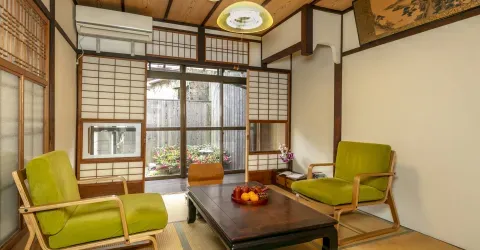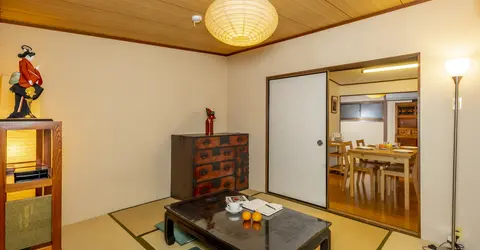Toji Market Kyoto: A vibrant monthly flea market at a UNESCO World Heritage Site
- Published on : 24/04/2024
- by : Japan Experience
- Youtube
Nestled in the heart of Kyoto, the Toji Market transforms the serene grounds of Kyoto's Toji Temple into a bustling bazaar on the 21st day of each month. This vibrant flea market, also known as Kobo-san, offers visitors a unique glimpse into Japanese culture, history, and craftsmanship. From antique treasures to local delicacies, Toji Market presents an unparalleled shopping experience against the backdrop of a UNESCO World Heritage Site. Whether you're a seasoned bargain hunter or a curious traveler, this monthly event promises an unforgettable journey through Japan's rich cultural tapestry.
What is Toji Market and when does it take place?
Toji Market, locally known as Kobo-san or Kobo-ichi, is a monthly flea market held at Toji Temple in Kyoto. It takes place on the 21st of every month, commemorating the death anniversary of Kobo Daishi (Kukai), the founder of Shingon Buddhism. The market opens early in the morning, usually around 6:00 AM, and continues until about 4:30 PM.
This market is not just a shopping destination but also a cultural event deeply rooted in Japanese tradition. It attracts hundreds of vendors who set up their stalls as early as 8:00 or 9:00 AM, offering a wide array of goods ranging from antiques and crafts to street food and plants. The market's unique setting within the grounds of Toji Temple, with its iconic five-story pagoda serving as a backdrop, adds to its allure and cultural significance.
In addition to the main market on the 21st, there's also a smaller antique market held on the first Sunday of each month, known as the Garakuta-ichi. This provides visitors with two opportunities each month to experience the vibrant market atmosphere at Toji Temple.

Toji market, Toji Temple, Kyoto
Navigating the market: Tips for bargaining and best times to visit
To make the most of your visit to Toji Market, consider these tips:
1. Timing is key: The market gets busiest between 10 AM and noon. For a more relaxed experience, arrive early around 9 AM when the market is just getting into full swing. Alternatively, visit later in the afternoon around 3-4 PM when vendors are more likely to offer discounts.
2. Bargaining is acceptable: Unlike many places in Japan, haggling is common at Toji Market. A polite "chotto makete kudasai" (please give me a small discount) can often result in a price reduction of about 10%.
3. Come prepared: Bring cash, as many vendors don't accept cards. Comfortable shoes are a must for navigating the crowded pathways.
4. Learn some Japanese phrases: Even basic Japanese can help you communicate with vendors and potentially get better deals.
5. Be respectful: Remember that you're shopping on temple grounds. Maintain a respectful demeanor and be mindful of other visitors and worshippers.
By following these tips, you'll be well-equipped to navigate the market and make the most of this unique shopping experience.

Toji market, Toji Temple, Kyoto
Diverse offerings: From antiques to street food
Toji Market boasts an impressive variety of goods, catering to all interests and budgets. Here's a glimpse of what you can expect:
Antiques and Collectibles: The market is a treasure trove for antique enthusiasts. You'll find a wide range of items including:
- Ceramics and porcelain
- Vintage kimonos and textiles
- Calligraphy scrolls and ukiyo-e prints
- Samurai swords and other historical artifacts
- Vintage toys and folk crafts
Handcrafted Goods: Many local artisans showcase their work, offering unique, handmade items such as:
- Pottery and ceramics
- Handwoven textiles
- Wooden crafts and furniture
- Jewelry and accessories
Plants and Gardening: Garden enthusiasts will appreciate the selection of:
- Bonsai trees
- Seasonal flowers and plants
- Seeds and gardening tools
Street Food: No visit to Toji Market is complete without sampling the delicious street food. Popular options include:
- Takoyaki (octopus balls)
- Yakitori (grilled chicken skewers)
- Taiyaki (fish-shaped pastries filled with sweet bean paste)
- Kakigori (shaved ice dessert)
This diverse array of offerings ensures that every visit to Toji Market is a new adventure, with something to appeal to all tastes and interests.

Ceramics are a popular item

Kimono for sale
The cultural significance of Toji Temple and its market
Toji Temple, officially known as Kyō-ō-gokoku-ji, holds immense cultural and historical significance in Japan. Founded in 796 CE, it was one of only three Buddhist temples allowed in Kyoto when the city became Japan's capital. The temple's five-story pagoda, standing at 57 meters, is the tallest wooden tower in Japan and a symbol of Kyoto's skyline.
The monthly market at Toji adds another layer to the temple's cultural importance. It serves as a living link between Japan's past and present, allowing visitors to experience traditional commerce in a historical setting. The market's origins are tied to religious observances, commemorating Kobo Daishi, the founder of Shingon Buddhism who was once the head priest at Toji.
Today, Toji Market represents more than just a shopping event. It's a celebration of Japanese craftsmanship, culinary traditions, and social interaction. The market provides a platform for artisans to showcase their skills, preserving traditional crafts and passing them on to new generations. It also offers a glimpse into everyday Japanese life, as locals and tourists alike come together to browse, bargain, and enjoy the festive atmosphere.
As a UNESCO World Heritage Site, Toji Temple and its market play a crucial role in preserving and promoting Japanese culture. They offer visitors a unique opportunity to engage with Japan's rich heritage in a tangible, immersive way.

Toji market takes place in the grounds of Toji Temple, Kyoto, on the 21st of each month
Alternative markets in Kyoto: Tenjin-san and Tezukuri-ichi
While Toji Market is undoubtedly a highlight, Kyoto offers several other notable markets that are worth exploring:
Tenjin-san Market at Kitano Tenmangu Shrine:
- Held on the 25th of each month
- One of the largest markets in the Kansai region
- Features over 1,000 stalls selling antiques, crafts, and food
- Located at the beautiful Kitano Tenmangu Shrine
Tezukuri-ichi Market at Chionji Temple:
- Takes place on the 15th of each month
- Specializes in handmade arts and crafts
- Offers a wide range of items including ceramics, jewelry, and textiles
- Located in the picturesque Hyakumanben area
These markets, along with Toji Market, form a trio of monthly markets that showcase different aspects of Kyoto's rich cultural heritage. Each has its own unique atmosphere and specialties, providing visitors with diverse shopping experiences throughout the month.
By exploring these different markets, visitors can gain a more comprehensive understanding of Kyoto's vibrant market culture and the various traditions they represent. Whether you're interested in antiques, handmade crafts, or local food, these markets offer something for everyone, making them essential stops on any Kyoto itinerary.
Experiencing Japanese hospitality through shopping at Toji Market
Shopping at Toji Market offers more than just the opportunity to purchase unique items; it provides a window into Japanese culture and hospitality. The market embodies the essence of "omotenashi," the Japanese concept of wholehearted hospitality and service.
Visitors to the market will experience:
- Patient and attentive vendors: Sellers at Toji Market are known for their patience and willingness to explain their products, even to non-Japanese speakers.
- Respect for customers: You'll notice that vendors treat all potential buyers with equal respect, regardless of whether a purchase is made.
- Meticulous presentation: Items are often beautifully displayed, reflecting the Japanese attention to detail and aesthetic sense.
- Cultural exchange: Many vendors are happy to share stories about their products, offering insights into Japanese traditions and craftsmanship.
This unique shopping experience allows visitors to engage with local culture in a meaningful way. It's not uncommon to find vendors who speak some English, making communication easier for international visitors. The relaxed atmosphere of the market encourages interaction, creating opportunities for cultural exchange and learning.
Moreover, the act of bargaining, while not as aggressive as in some other countries, introduces visitors to a different facet of Japanese communication. It's a chance to practice politeness and negotiation skills in a friendly environment.
By immersing yourself in the Toji Market experience, you'll gain a deeper appreciation for Japanese hospitality and the cultural values that underpin it. This makes shopping at the market not just a commercial transaction, but a valuable cultural experience in itself.

The market at Toji on a wet January day
Practical information: Location, access, and opening hours
Location: Toji is located in the Minami-ku ward of Kyoto, approximately a 15-minute walk southwest of Kyoto Station.
Access:
- From Kyoto Station: Walk southwest for about 15 minutes.
- By subway: Take the Karasuma Line to Kujo Station. Toji is a 5-minute walk from there.
- By train: Take the Kintetsu Kyoto Line to Toji Station, which is slightly closer to the market than Kujo Station.
- By bus: Routes 202, 205, and 207 stop near the temple.
Opening Hours:
- The market is held on the 21st of every month.
- Hours: Generally from early morning (around 6:00 AM) until about 4:30 PM.
- The temple grounds are usually open from 8:00 AM to 5:00 PM.
Tips for Visitors:
- Arrive early to avoid crowds and get the best selection of goods.
- Bring cash, as many vendors don't accept credit cards.
- Wear comfortable shoes as you'll be doing a lot of walking.
- Consider visiting the temple itself while you're there. The Toji Market Antiques section often spills into the temple grounds.
- Check the Toji Market Access information before your visit to plan your route.
Remember, Toji Market offers a unique blend of shopping, culture, and history. By keeping these practical tips in mind, you can ensure a smooth and enjoyable visit to this vibrant Kyoto attraction. Don't forget to check out the Toji Market Video for a visual preview of what to expect!
For those interested in delving deeper into Japanese culture beyond the market, consider exploring other aspects of Kyoto or picking up some Books on Japanese Culture to enhance your understanding and appreciation of this fascinating country.




























